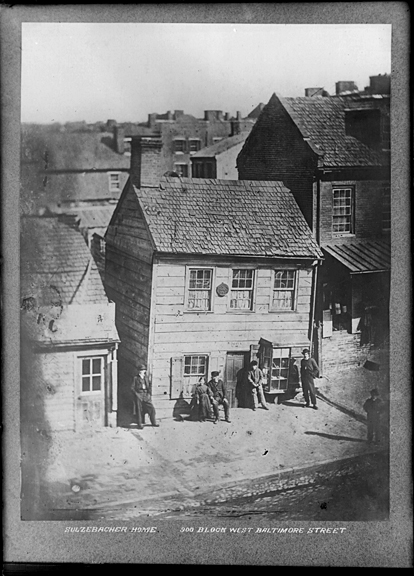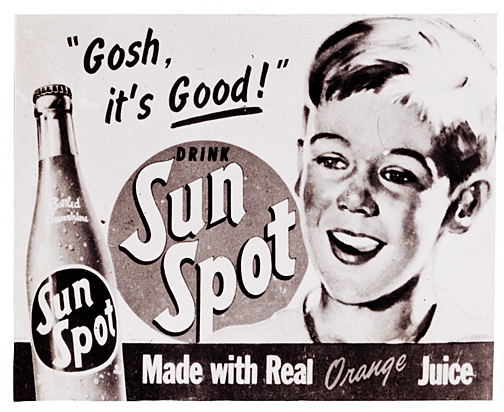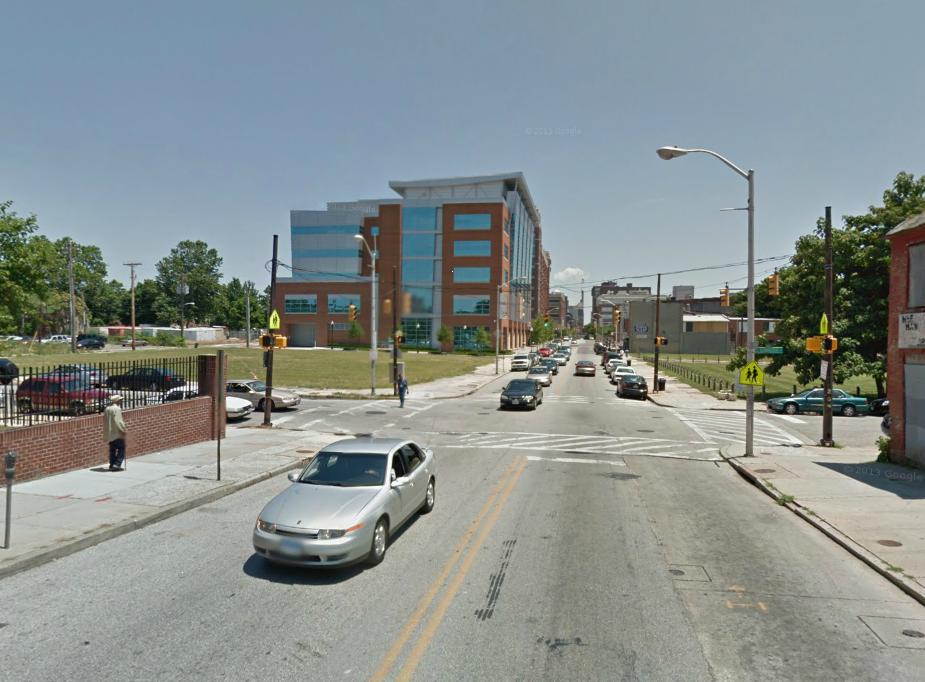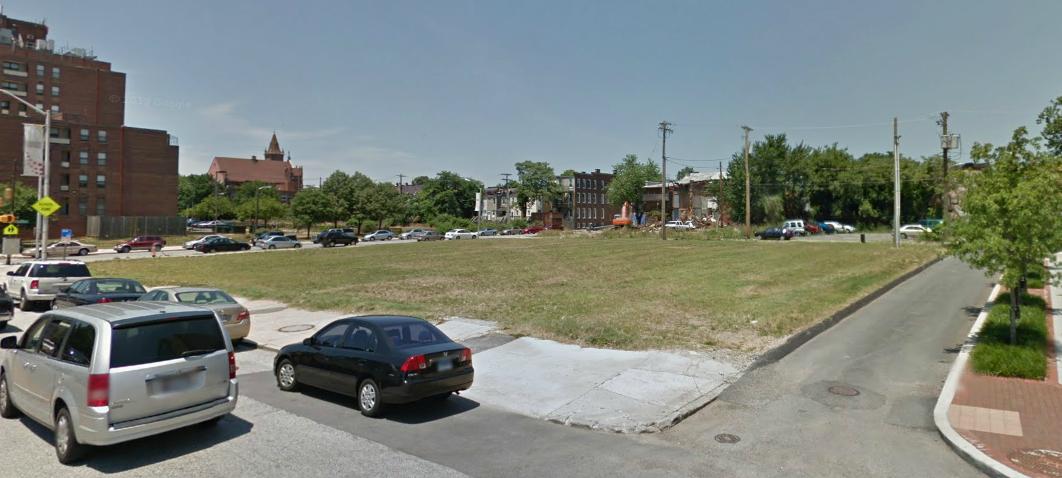Lost City: The Sulzebacher House
West Baltimore was once a densely packed, vibrant neighborhood full of theaters, local businesses, and industry. Drive down many of the streets today and you’re likely to see a vacant lot or a boarded up row house on nearly every other block. But even an empty field has a history. The tiny, off-kilter house pictured to the left is one of the oldest houses in West Baltimore. Or at least it was circa 1865 when the photograph was taken. Like many of Baltimore’s historic structures it has been lost to time and the march of progress. It is now the site of a vacant lot. Built in the mid-1700s, the two-story wood frame house was located at 930 West Baltimore Street, two doors west of Amity Street. The property is known as the Sulzebacher house. The name is most likely a corruption of Sulzbach; according to the Baltimore city directories, a currier named Peter Sulzbach occupied the residence for a few years in the 1840s.
The house is of typical design for a mid-eighteenth century home in Baltimore. The gable roof may point to the construction of the home in the 1760s or 1770s; by then “gambrel roofs had fallen out of favor and most frame houses were a full two stories in height, with gable roof, with or without dormers.”* The building’s obvious tilt was characteristic of structures “located on streets built to match a since-altered street grade.”** Visible on the second floor is a fire insurance seal. Also called a fire mark, these iron, copper, or lead emblems indicated that a specific insurance firm paid a volunteer fire department to protect it – Baltimore’s first paid fire department was established in 1859, but the fire seals often remained left on the buildings. The Sulzebacher house survived for over 150 years, no mean feat for a wood frame house from that period. Sometime before 1911 the house was razed – the structure is not visible on the 1911 edition of the Sanborn fire insurance atlas – and replaced by a three-story barber shop.
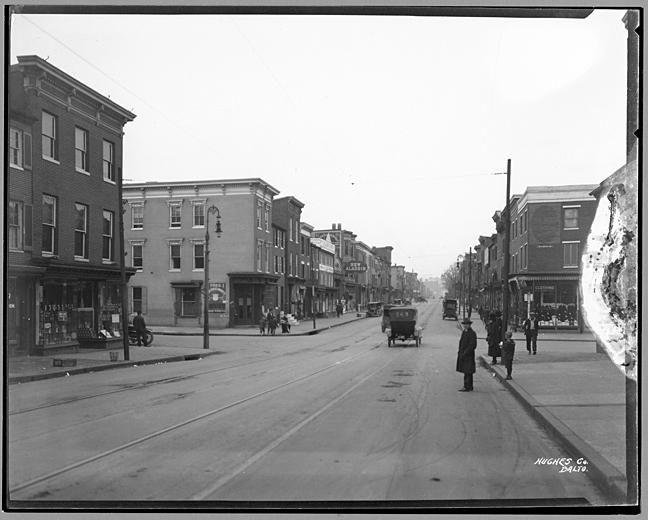
Baltimore Street, 900 block west, looking east, 1920, Hughes Company, MdHS, MC6284. A sign for the New Aladdin Theater is visible in the center of the photograph. (Click to enlarge)
The house at 932 West Baltimore Street, the edge of which can be seen in the photograph, may have been even older. Built in the same period, it had a much larger frontage than its neighbor at 930. The original structure was razed just a few years prior to the Sulzebacher house to make way for a motion picture theater. Both 932 and 930 West Baltimore Street appear to have caught the eye of rival theater owners. At around the same time that James W. Bowers was pursuing the properties at 932, A. Freedman had similar designs on 930. Freedman apparently lost the contest, because the only theater that debuted was Bower’s Aladdin Theater, which opened its doors to the public near the end of 1909. Advertising itself as “West Baltimore’s finest motion picture house,” the Aladdin theater seated about 400 patrons.
Between 1910 and 1938 the theater changed both ownership and names a number of times. In 1917 J. Louis Rome purchased it and renamed it the New Aladdin. The following year it came under the control of C.E. Nolte and his partner, Baltimore-born movie mogul Frank Durkee, whose Durkee Enterprises owned or controlled a large number of the movies houses in Baltimore, including the Ritz, the Palace, the Arcade, and the Senator. In 1930 the theater became the New Queen. It was open for less than a year, perhaps closing from the effects of the Great Depression. Then from 1933 to 1938 it operated as the segregated Booker T. Theater. This was the last of the property’s run as a host for cinematic productions – in 1942 it was converted into a plant for the New Gold Bottling Company, a soft drink manufacturer.
The New Gold Bottling Company was founded in 1925 by Greek immigrant Dionicios Karavedas. The company went on to produce Sun Spot, a popular orange flavored soft drink, whose advertisements boasted that it was made with real orange juice. During the 1950s and 1960s, the beverage, which retailed for a nickel, could be found in neighborhood stores and confectionaries throughout the city. The riots of 1968, which hit West Baltimore particularly hard, led to a decline in business for the soft drink manufacturer. In an odd change of direction, Dionicios’s son Nicholas, who took over the company after his father retired in 1960, began producing a sugar detecting beverage alongside his sugar enhancing ones – in the 1970s, he was involved with developing a product known as GTTS (Glucose tolerance testing solution) that detected the presence of gestational diabetes in pregnant women. Through a new company, Custom Laboratories, Inc., Karavedas went on to become the “the largest supplier of glucose testing solutions in the country.”***
By the 1980s, the beverage companies were still producing their dissimilar drinks on West Baltimore Street. But the city had its own plans for the site. In the mid-1980s it began purchasing properties on both the 900 and 800 blocks of West Baltimore Street for a proposed redevelopment project.
By 1992 the Karavedas owned companies were the remaining holdouts. According to a Baltimore Sun article from that year, the beverage companies were “the last tenants on a block the city has been clearing for as-yet unspecified housing or commercial redevelopment use.”**** By 1998, they had relocated across the city to Highlandtown. Twenty years later the 900 block of West Baltimore street, now owned by the University of Maryland, still remains undeveloped, a field of grass surrounded by a mixture of boarded up row homes, storefronts, University of Maryland medical buildings, and vacant lots. (Damon Talbot)
Footnotes:
*Hayward, Mary Ellen & Frank R. Shivers Jr., ed., The Architecture of Baltimore: An Illustrated History (Baltimore: JohnsHopkinsUniversity Press, 2004), p. 9.
**The Passano Files, Baltimore Street (928, West)
***Kelly, Jacques, “Nicholas D. Karavedas, beverage producer, dies,” The Baltimore Sun, October 19, 2010.
****”Boondoggle on Baltimore Street,” The Baltimore Sun, March 16, 1992.
Sources and further reading:
”Boondoggle on Baltimore Street,” The Baltimore Sun, March 16, 1992.
The Dielman-Hayward File, Karavadas, Dionicios
Hayward, Mary Ellen & Frank R. Shivers Jr., ed., The Architecture of Baltimore: An Illustrated History (Baltimore: JohnsHopkinsUniversity Press, 2004)
Headley, Jr, Robert Kirk, Exit: A History of the Movies in Baltimore (University Park, Md: Robert Kirk Headley, Jr., 1974)
Headley, Jr, Robert Kirk, Motion Picture Exhibition in Baltimore: An Illustrated History and Directory of Theaters, 1895-2004 (London: McFarland & Company, Inc., Publishers, 2006)
Jones, Carleton, Lost Baltimore: A Portfolio of Vanished Buildings (Baltimore: Maclay & Associates., 1982)
Kelly, Jacques, “Nicholas D. Karavedas, beverage producer, dies,” The Baltimore Sun, October 19, 2010.
Life Magazine, December 24, 1965
The Passano Files, Baltimore Street (928, 930-932, West)
http://cinematreasures.org/theaters/9958


